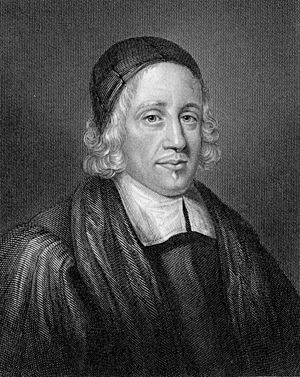John Lightfoot facts for kids
John Lightfoot (born March 29, 1602 – died December 6, 1675) was an important English churchman. He was also a scholar who studied ancient Jewish writings. He held big jobs like Vice-Chancellor of the University of Cambridge and Master of St Catharine's College, Cambridge.
Contents
John Lightfoot's Early Life and Education
John Lightfoot was born in Stoke-on-Trent, England. His father, Thomas Lightfoot, was a vicar, which is a type of church leader. John went to school near Congleton and then to Christ's College, Cambridge. At college, he was known as a great speaker.
After finishing his studies, he worked as an assistant teacher at Repton School. Later, he became a curate, helping out at a church in Norton in Hales. There, a man named Sir Rowland Cotton noticed him. Sir Rowland was interested in the Hebrew language, and he hired John as his personal chaplain.
Lightfoot then worked at a church in Stone, Staffordshire for about two years. After that, he moved closer to London to use the large library at Sion College.
Becoming a Minister and Scholar
In 1630, John Lightfoot became the rector of Ashley, Staffordshire. He stayed there until 1642. Around this time, he moved to London to publish his book, A Few and New Observations upon the Book of Genesis. This book shared new ideas about the first book of the Bible. He also became a minister at St Bartholomew's Church in London.
Role in the Westminster Assembly
Lightfoot was one of the first members of the Westminster Assembly. This was a very important meeting of religious leaders. They met to discuss how the church in England should be run. John Lightfoot attended these meetings regularly. He often shared his own strong opinions, and his ideas helped shape the discussions. His notes from these meetings are a valuable historical record.
Leading Cambridge University
In 1643, Lightfoot was chosen to be the Master of St Catharine's College, Cambridge. This is a big leadership role at a university. He also became the rector of Great Munden in Hertfordshire. He kept both of these important jobs for the rest of his life.
In 1654, he was chosen as the Vice-Chancellor of the University of Cambridge. This meant he was in charge of the whole university for a time. Even with these big roles, he continued to live in Munden. After the English monarchy was restored, he was confirmed in both his positions.
Later Life and Legacy
In 1668, John Lightfoot received another church position in Ely, England. While traveling there from Cambridge, he caught a bad cold. He died in Ely on December 6, 1675.
Lightfoot loved books, especially those about the Old Testament. He left his large collection of these books to Harvard University in America. Sadly, his library was destroyed in a fire at Harvard in 1764.
John Lightfoot's Published Works
John Lightfoot wrote many books during his life. His first book, called Erubhin, was published in 1629. It was a collection of his thoughts on Christian and Jewish topics.
In 1643, he published A Handful of Gleanings out of the Book of Exodus. He also gave an important sermon to the House of Commons of England, which was later published as Elias Redivivus. In this sermon, he talked about the need for church reform.
Understanding the Bible
Lightfoot worked on a big project called The Harmony of the Four Evangelists. This work tried to show how the four Gospels in the Bible (Matthew, Mark, Luke, and John) fit together. It also explained difficult parts of the text. He published this work in several parts between 1644 and 1650.
He also wrote about the timing of events in the Bible. For example, he believed that the world was created in 3929 BC. This idea is part of what is known as the Ussher chronology.
Lightfoot also helped with the Polyglot Bible (1657). This was a special Bible printed in many different languages.
His Most Famous Work
His most well-known work was the Horae Hebraicae et Talmudicae. In these books, he explored Jewish writings to help people better understand the Bible. He published volumes related to the Gospels of Matthew, Mark, John, and Luke, as well as the book of 1 Corinthians, between 1658 and 1674. Other parts of this work were published after he died.
His writings showed his deep knowledge of ancient Jewish texts and how they could shed light on Christian scriptures.
Images for kids



